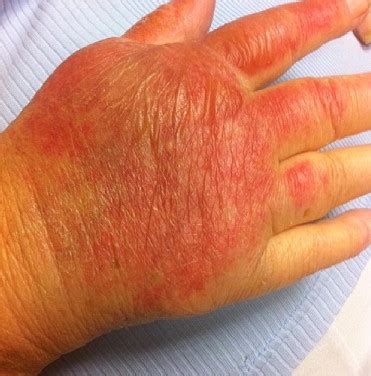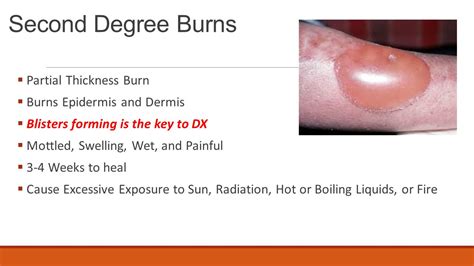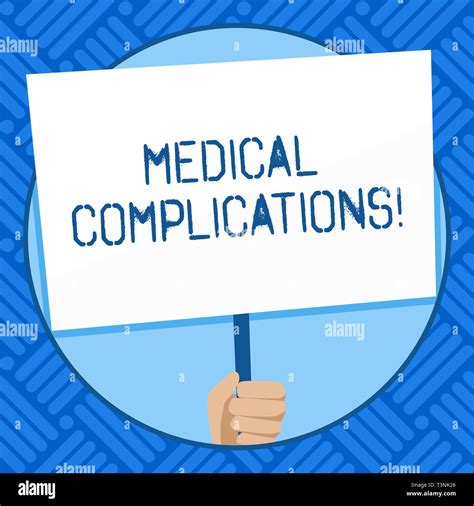Intro
Heal 2nd degree burns with our guide on burn healing stages, including blistering, scabbing, and skin regeneration, to promote wound care and minimize scarring.
The process of healing from a 2nd degree burn, also known as a partial-thickness burn, involves several stages. Understanding these stages is crucial for promoting proper healing, preventing infection, and minimizing the risk of scarring. 2nd degree burns affect both the epidermis and the dermis, the outer and inner layers of the skin, respectively. This type of burn is characterized by the presence of blisters, redness, and pain.
The healing process of 2nd degree burns is complex and involves various physiological responses. Initially, the body's immediate response to a burn is inflammation, which is a defensive mechanism aimed at removing the harmful stimulus and initiating the healing process. Following inflammation, the body starts to clean the wound, remove dead tissue, and prepare the ground for new tissue growth. This process is highly dependent on the individual's overall health, the size and depth of the burn, and the quality of care provided to the wound.
Effective wound care is critical in the healing stages of 2nd degree burns. This includes keeping the wound clean and moist, applying topical creams or gels as prescribed by healthcare professionals, and protecting the wound from further injury. Proper care can significantly reduce the risk of infection and promote a faster recovery. Additionally, nutritional support plays a vital role in the healing process, as the body requires adequate amounts of protein, vitamins, and minerals to repair damaged tissues.
Introduction to 2nd Degree Burn Healing

Understanding Burn Severity
Before diving into the healing stages, it's essential to understand the severity of burns. Burns are classified into four degrees based on their severity: first-degree (affecting only the outer layer of skin), second-degree (involving the outer and inner layers), third-degree (extending through all layers of skin), and fourth-degree (extending through both layers of the skin and into deeper tissues). 2nd degree burns are further divided into superficial and deep, depending on the extent of dermal involvement.Healing Stages of 2nd Degree Burns

- Inflammation Stage: This is the body's initial response to injury, lasting about 0-4 days. It involves increased blood flow to the affected area, which may cause redness, swelling, and warmth.
- Debridement Stage: During this phase (approximately 0-10 days), the body removes dead tissue, bacteria, and other foreign materials from the wound. This process can occur naturally or may require surgical intervention.
- Granulation Stage: Lasting from about 4-21 days after the burn, this stage involves the growth of new tissue, including blood vessels, over the wound site. The wound starts to look red, granular, and bleeds easily.
- Epithelialization Stage: This stage (approximately 7-14 days after injury) is where the wound is covered by new epithelial cells, gradually restoring the skin's barrier function.
- Remodeling Stage: The final stage, which can last from 21 days up to 2 years or more, involves the strengthening of the new tissue. The collagen in the new tissue is remodeled, improving the wound's strength and reducing the appearance of the scar.
Factors Influencing Healing
Several factors can influence the healing process of 2nd degree burns, including the size and depth of the burn, the presence of infection, the nutritional status of the individual, and the quality of wound care provided. Larger and deeper burns take longer to heal and are at a higher risk of complications. Infections can significantly delay healing by causing further tissue damage and prolonging the inflammatory phase.Wound Care for 2nd Degree Burns

Nutritional Support
Nutrition plays a critical role in the healing process. Burn patients often have increased nutritional requirements due to the metabolic response to injury, which includes increased energy expenditure and protein breakdown. Adequate intake of proteins, vitamins (especially vitamin C and A), and minerals (such as zinc) is essential for tissue repair and immune function.Complications and Prevention

Psychological Support
The psychological impact of burns should not be underestimated. Burn survivors may experience anxiety, depression, and post-traumatic stress disorder (PTSD). Support from family, friends, and mental health professionals can play a vital role in the recovery process, helping individuals cope with their injuries and any resulting changes in appearance or ability.Conclusion and Future Directions

Final Thoughts
Recovery from a 2nd degree burn is a journey that requires patience, proper care, and support. Understanding the healing stages and factors that influence them can empower individuals to take an active role in their recovery. By combining evidence-based wound care practices with a holistic approach to health, including nutritional support and psychological care, individuals can navigate the healing process with the best possible outcomes.What are the stages of healing for a 2nd degree burn?
+The stages include inflammation, debridement, granulation, epithelialization, and remodeling, each playing a critical role in the wound healing process.
How can I promote healing and prevent infection in a 2nd degree burn?
+Keeping the wound clean, applying topical antibiotics as directed, using non-stick dressings, and monitoring for signs of infection are key strategies. Adequate nutrition and hydration also support the healing process.
What are common complications of 2nd degree burns?
+Common complications include infection, scarring, and contractures. Infection can be particularly dangerous and requires prompt medical attention if suspected.
We hope this comprehensive guide to the healing stages of 2nd degree burns has been informative and helpful. If you have any further questions or would like to share your experiences with burn recovery, please don't hesitate to comment below. Your insights can provide valuable support and information to others navigating the healing process.
